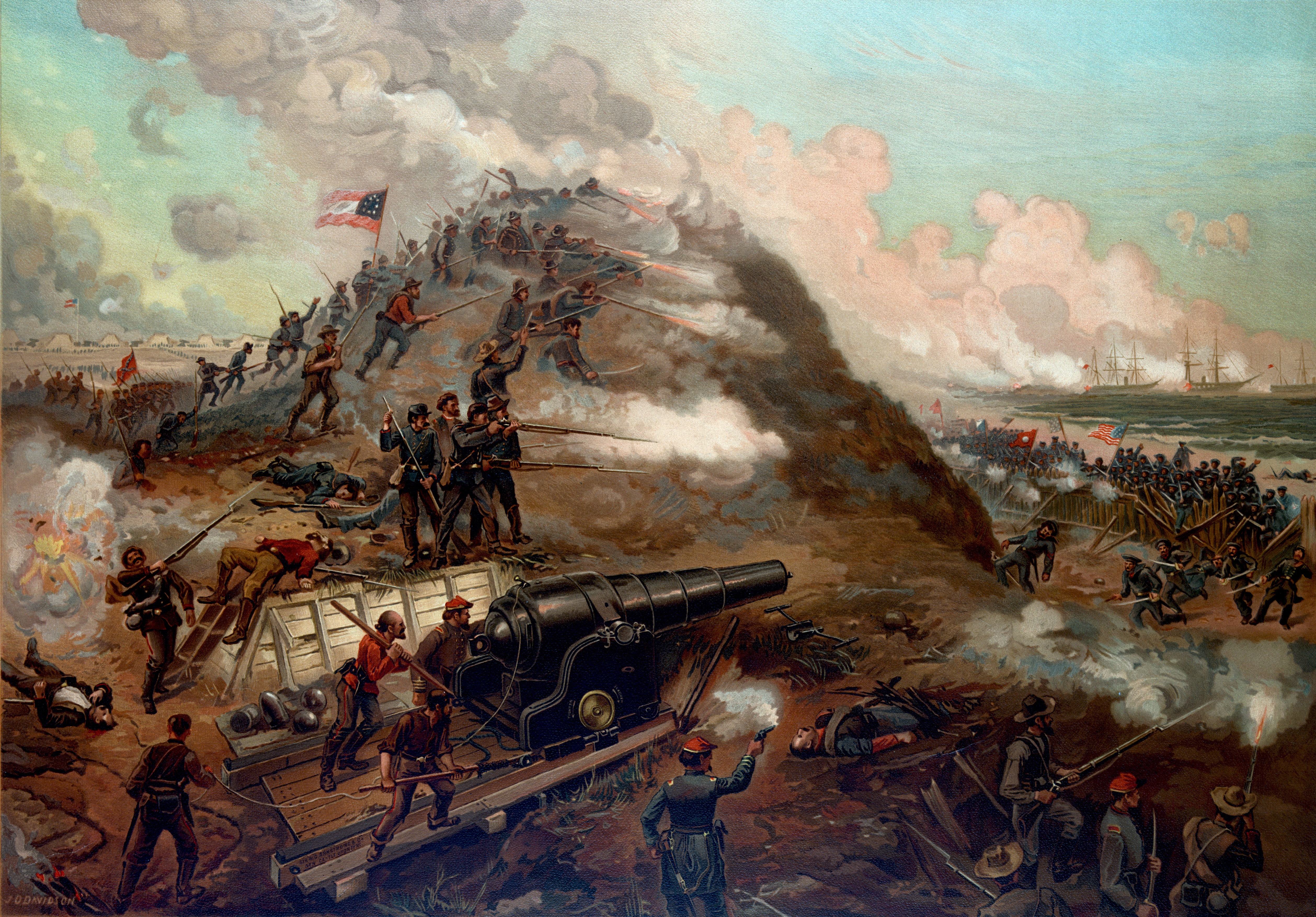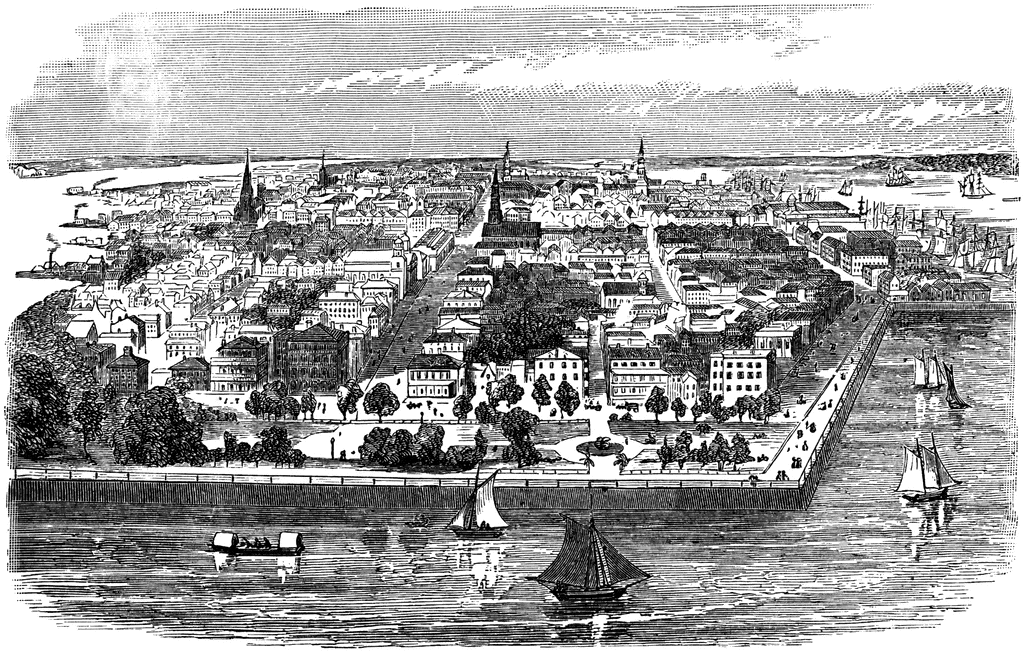Chapter III: The Battle of Fort Fisher
Situated at the end of Confederate Point some 25 miles south of Wilmington between the Cape Fear River and the Atlantic, Fort Fisher was the guardian angel of the blockade-running fleet. Protection was accorded to the supply line from Europe, primarily Britain, by virtue of the heavy seacoast guns of the large and formidable Fort Fisher. From late 1861, and especially by the summer of 1862 after Colonel William Lamb took command of Fort Fisher, blockade-runners brought a constant stream of food, clothes, shoes, coffee, rifles, ammunition, percussion caps, cannon, medicine, uniforms, accoutrements, and virtually anything to sustain an army and a people. Robert E. Lee’s Army of Northern Virginia, the most successful of all the Confederate armies, was the primary recipient of those supplies. Fort Fisher’s success in protecting the blockade-runners from Union gunboats likely kept the Confederate States alive.
On November 15, 1864, General Braxton Bragg again notified President Davis of rumored Union plans for an amphibious attack on Fort Fisher and especially complained of the small number if troops in the area as well as their lack of experience. He warned that Fort Fisher would be overrun and Wilmington lost if defense of the area depended on home guards, reserves and untried artillery.
With Bragg's concerns about Wilmington and Fort Fisher largely unresolved in late December, General Theophilus Holmes, commander of North Carolina's reserve forces, volunteered his service and Bragg put him in charge of Wilmington while sending Whiting to be with Colonel Lamb directly at the fort.
On December 18, the Federal invasion force left Hampton Roads and sailed towards Fort Fisher. General Benjamin Butler's and the 6,500 soldiers designated to make the landing arrived at the same time when Gordon's troops reached Wilmington on the 23rd.
One day later, an old hulk filled with tons of black powder was detonated near the fort. The explosion, particularly loud in Wilmington, accomplished nothing at Fort Fisher, with the exception of terrifying a battalion of Junior Reserves camped on the beach.
Having failed in an unconventional attempt to reduce Fort Fisher, Admiral David D. Porter's gunboats bombarded the fort in preparation for Butler's amphibious landing.
Major General Whiting arrived at the fort from Wilmington late in the afternoon of Christmas Eve, not to take command from Colonel Lamb, but to assist him and share the fate of the garrison. At about the same time, Brigadier General William Terry's Consolidated Virginia Brigade of John B. Gordon's Division began arriving at the Sugar Loaf defenses, four and five miles north of Fort Fisher. There were heavy guns as well as Whitworth rifles in some of these extensive sand fortifications, and Terry planned to make a stand against the expected Union landing, if he could. As the afternoon wore into dusk, the fleet withdrew from the battle to rest for the night.
Shortly after 2:00 p.m. on Christmas Day, the Union infantry began coming ashore from gigs and launches of the transports. Brigadier General Newton M. Curtis' Brigade of Adelbert Ames’ Division landed and began to form up to advance on the fort. Two other brigades of Ames’ Division came ashore and remained near the landing area, skirmishing with some of Terry’s men who moved out to contest, if only feebly due to paucity of numbers, the Union landing.
As Curtis' troops got to within about 100 yards of the fort, the fleet lifted its fire. Colonel Lamb immediately dispatched his garrison on the land face from bombproofs up to the ramparts to man their guns. Other troops, many of them North Carolina Junior Reserves, were ordered to get down from the parapets to man a heavy log palisade fence about 50 feet north of the base of the fort. As Curtis' men came within musket range in the growing darkness, the troops behind the palisade opened a heavy musketry, while the artillery blasted away with canister and grapeshot.
Butler, observing the twilight fighting, called the attack off, concluding, had the attack been made it would have failed. Division commander Adelbert Ames concurred with his decision. Additionally, the fleet had exhausted its ammunition of all things, and was forced to leave the Cape Fear coast and return to Beaufort, North Carolina to replenish its supply.
The Federals re-embarked 2,800 of their 3,500 troops that had landed. The balance, 700 men, were stranded as another gale blew in, forcing the transports to move far offshore. Gordon, who had arrived at the Sugar Loaf Line late on 25 December with the rest of his division, grasped the situation immediately and his natural instinct told him to attack the following day. While Peck's Louisianans and Terry's Virginians held Curtis's front in check, Evans's Georgia Brigade swung around the Northerners' right flank and poured a galling fire into their ranks. Without support, with dwindling ammunition and with their backs to the foaming sea, the New Yorkers could only return fire for a few minutes before Curtis raised the white flag and surrendered.
The Union attack on Fort Fisher ended in a huge disaster and was to be the military end for Benjamin Butler. The Northerners suffered over 900 casualties, including nearly 700 prisoners. Neither had the fleet succeeded in damaging the fort's defences, nor could a bridgehead be established. The threat to Wilmington had been averted for the time being.
Order of Battle
CSA
MG John B. Gordon, 6,400 men, 12 guns
BG Clement A. Evans' Division, 2,800 men
Col John H. Baker's Brigade, 1,300 men
13, 26, 31, 38, 60, 61st Georgia Infantry, 12th Georgia Infantry Battalion
BG William Terry's Brigade, 900 men
2/4/5/27/33, 10/23/37, 21/25/42/44/48th Virginia Infantry
Col William R. Peck's Brigade, 600 men
1/14, 2, 5/6/7, 8, 9, 10/15th Louisiana Infantry
MG William H. C. Whiting (Post of Ft Fisher) 3,600 men, 12 guns
Col William Lamb (Garrison of Ft Fisher) 2,100 men
Maj James Reilly, 400 men
1st North Carolina Heavy Artillery Battalion Company D, 3rd North Carolina Light Artillery Battalion Company C, 1st North Carolina Artillery Co F, K
Cpt Robert Murphy, 500 men
2nd North Carolina Artillery Company A, B, C, D, E
Cpt Daniel Patterson, 500 men
2 NC Art Co F, G, H, I, K
Cpt James Lane, 400 men
3rd North Carolina Artillery Company D, E, G, K
Cpt William Shaw, 100 men, 4 guns
13th North Carolina Light Artillery Battalion
Cpt A. C. van Benthuysen, 200 men
Confederate States Marines
Col John K. Connally's Brigade, 1,300 men
1, 4, 7, 8th Battalion North Carolina Junior Reserves
Cpt Thomas J Southerland, 100 men, 4 guns
Cpt Andrew B. Paris, 100 men, 4 guns
USA
MG Benjamin F. Butler, 6,500 men, 10 guns
2nd Division, XXIV Corps, BG Adelbert Ames
1st Brigade, BG Newton M. Curtis
3, 112, 117, 142th New York Infantry
2nd Brigade, Col Galusha Pennypacker
47, 48th New York Infantry, 76, 97, 203rd Pennsylvania Infantry
3rd Brigade, Col Louis Bell
13th Indiana Infantry, 4th New Hampshire Infantry, 115, 169th New York Infantry
Cpt Richard H. Lee
16th Independent Battery New York Light Artillery
3rd Division, XXV Corps, BG Charles J. Paine
2nd Brigade, Col John W. Ames
4, 6, 30, 39th United States Colored Troops
3rd Brigade, Col Elias Wright
1, 5, 10, 37, 107th United States Colored Troops
Lt John Myrick
Battery E, 3rd United States Artillery








:max_bytes(150000):strip_icc():format(webp)/william-t-sherman-large-56a61b425f9b58b7d0dff17c.jpg)